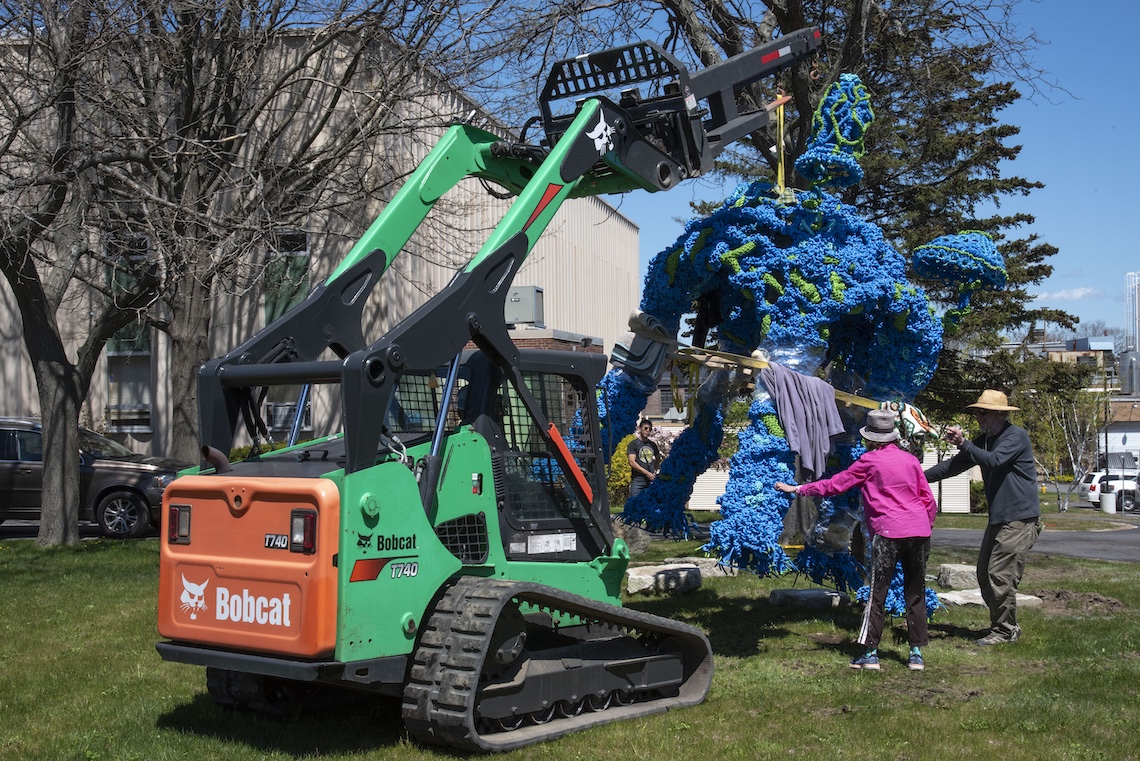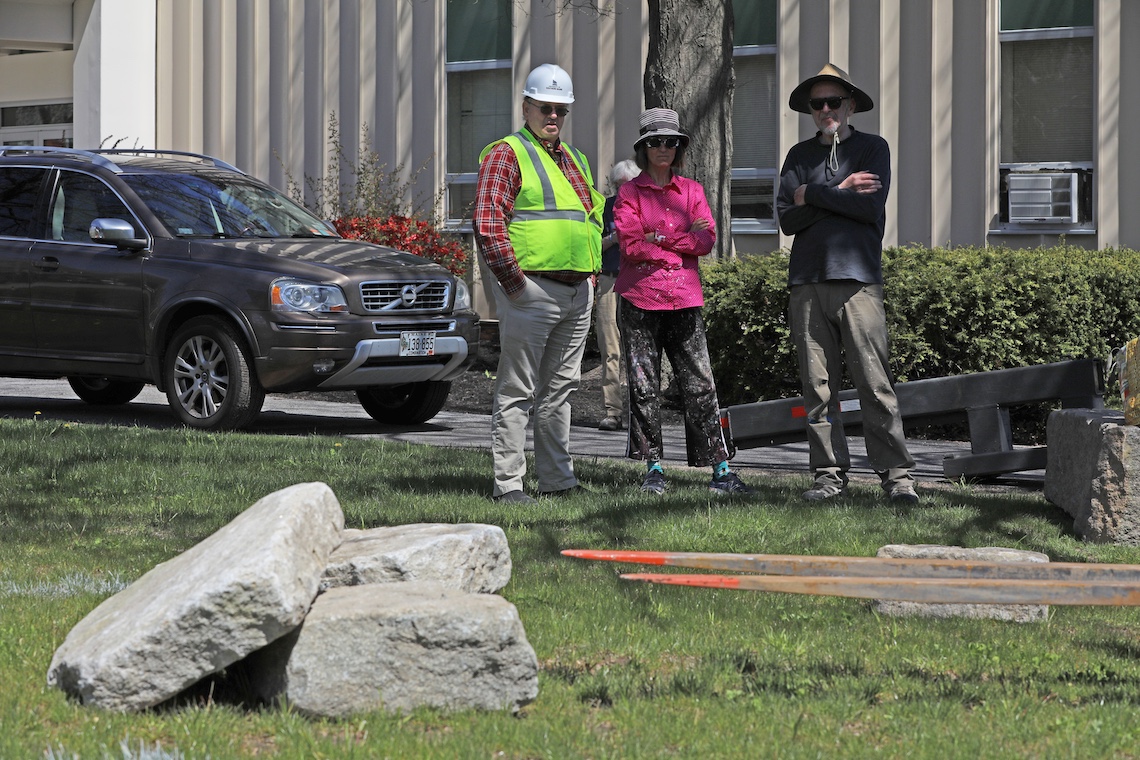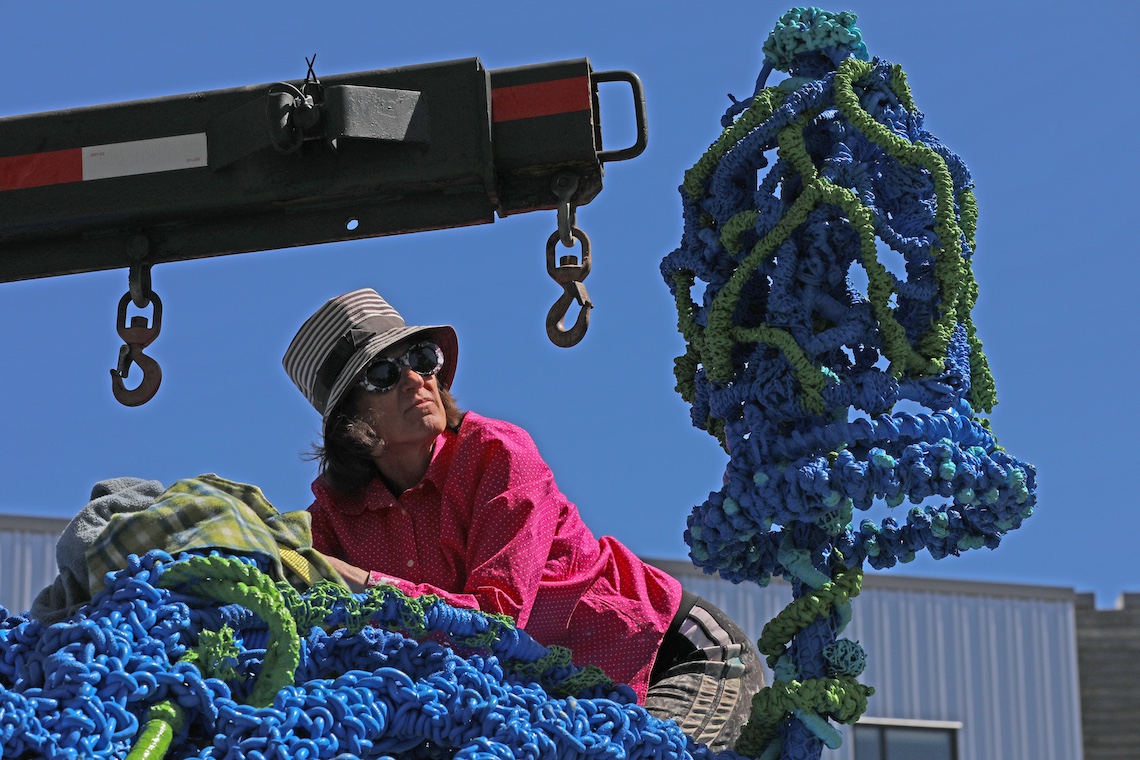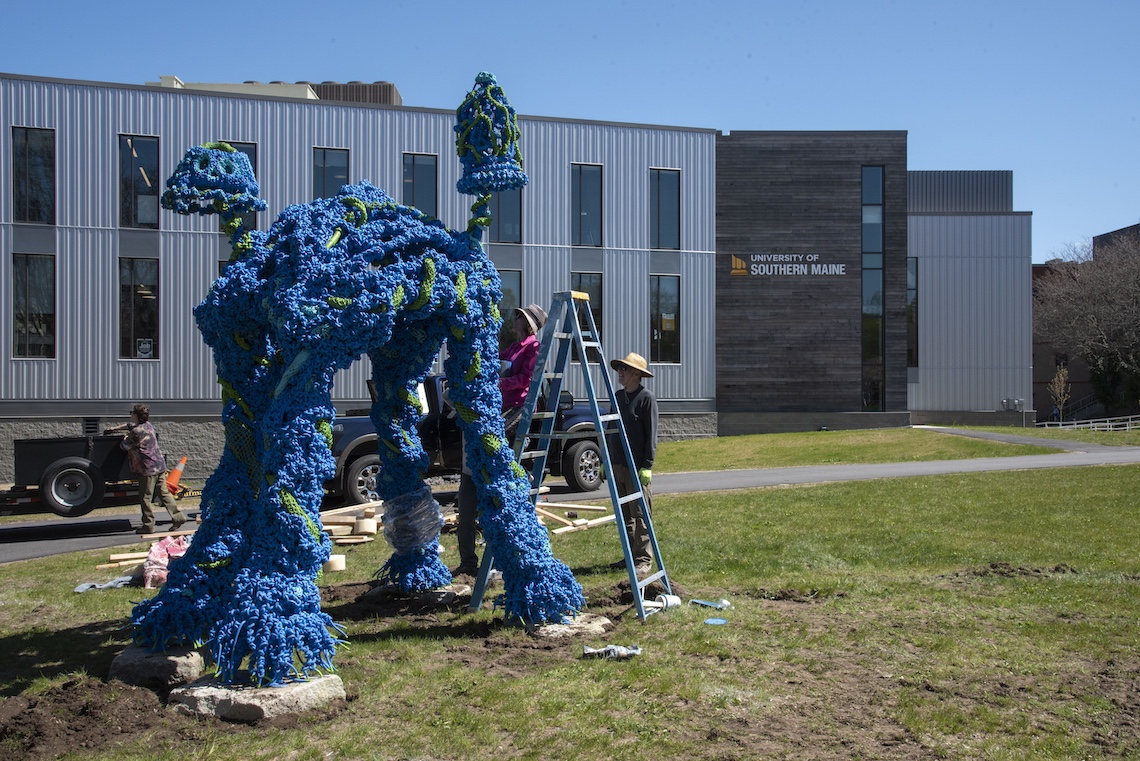Though only a short walk away, the ocean is out of sight from the University of Southern Maine’s Portland Campus. However, a new sculpture gives students the artistic equivalent of a waterfront view through the windows of their dorm rooms.

TANGLE, as the sculpture is called, was created by Pamela Moulton and Roy Fox. It stands at the crest of a grassy slope behind the McGoldrick Center for Career & Student Success and the adjoining Portland Commons residence hall.
“I thought it would be more delicate looking, but it actually is very monumental,” Moulton said. “It’s got a great presence. It lives here now; it’s planted so firmly on the ground. It takes ownership of where it is.”
The sculpture arrived at its new home on May 7 and immediately attracted attention. It’s an arching structure standing 14 feet tall on five sturdy legs and painted bright blue with streaks of green.
A steel skeleton gives TANGLE its basic shape. But its skin is made of old ropes and nets salvaged from fishing boats. If that gear hadn’t been turned into art, it could have ended up polluting the ocean or clogging landfills.
The committee that selected TANGLE for USM liked how it celebrates both environmentalism and the fishing industry. The message may not be immediately obvious, but it’s just beneath the sculpture’s undulating surface that so resembles an ocean current. Dr. Kelly Hrenko, Professor of Art Education, was part of the selection process.
“It’s this very fun, playful jungle gym thing,” Hrenko said. “It’s accessible on that level, but also it raises all these other questions. For me, as an art educator, the accessibility was really important.”

Funding for TANGLE came from the Percent for Art program, administered by the Maine Arts Commission. The program launched in 1979 under a state law requiring new construction projects that receive public money to reserve at least 1% of that funding for art. TANGLE is tied to the McGoldrick Center.
Work on TANGLE began last summer, around the same time that the McGoldrick Center opened. Moulton and Fox set up shop at the Lights Out Gallery in Norway, Maine. The former factory was converted into a communal space where artists can work side-by-side and engage with members of the community.
Moulton and Fox spent long days coiling strands of fishing gear over the steel frame. School groups made regular visits to see them work. Students asked questions and drew pictures. Some even helped with the weaving process at the artists’ direction.
It took months of layering the fishing gear to create the sinewy musculature that the artists envisioned. Next came the paint, followed by a protective waterproof sealant. They had brought TANGLE to life, but now they had to bring it to campus.
Too tall to make the trip upright, TANGLE was laid on its side and strapped down tightly onto the trailer of a flatbed truck. The trip from Norway to Portland spanned 45 miles. All along the way, pedestrians and passing drivers gawked at the bizarrely beautiful cargo.

The caravan’s arrival set off a flurry of activity. The installation team embedded five heavy stones into the ground to serve as the foundation for each of TANGLE’s five feet. A small crane first eased the sculpture upright then carefully hoisted it into place. A bolt through each foot ensured it wouldn’t budge.
Moulton and Fox were a bundle of emotions. They spent the trip fretting over every bump in the road. Their excitement grew with each step of the installation. And as their year of work reached its conclusion, professional pride washed over them.
“I feel like the proportions are right on target for the space, especially being nestled in the trees like this,” Moulton said. “It seems very human-sized to me, like a real human scale. When I was standing at a distance looking at it, it doesn’t seem overwhelming and large.”
The bustle of the installation aroused curiosity. Most students were gone for the summer, but a crowd of faculty and staff soon formed. Several of them lined up to congratulate the artists and share their impressions.
No two people see the same thing when they look at TANGLE. It occupies a middle ground between land and sea, architecture and nature. Is it a gazebo perhaps or maybe a coral reef? The growths projecting out of the roof might be mushrooms or stovepipes, church bells or tentacles. The ambiguity is intentional.
“I would never want to limit somebody’s imagination. We don’t know what it is either,” Fox said. “The feedback, that’s the exciting part really.”
Fox and Moulton are especially eager to hear the conversations that TANGLE inspires when the full student body returns for the fall semester. A stone bench beside the sculpture invites visitors.

Up close, the texture of the old ropes and netting becomes apparent, recalling their original purpose. The roof offers shade, but it’s porous enough for light to penetrate. Different people will find its presence conducive for study, performance, or even romance. There is no wrong way to interact with TANGLE.
“I wanted to create a gathering place where people could go inside, where light would pass through the top, but it’s still moving,” Moulton said. “If you look, it’s sort of alive. These different elements move through it. It’s a living, breathing creature.”
Moulton wants to make sure students see TANGLE at its best. It incurred a few minor scratches and dings in transport. She scanned the surface inch by inch, sometimes on her hands and knees, sometimes on a ladder. Only after tending to each flaw was she willing to finally part from the sculpture she labored so long to create.
Moulton’s separation from TANGLE is only temporary. She and Fox will come back to campus for the official unveiling ceremony on September 12.

